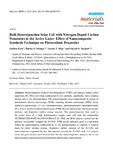| dc.contributor.author | Keru, Godfrey K. | |
| dc.contributor.author | Ndungu, P. G. | |
| dc.contributor.author | Mola, G. T. | |
| dc.contributor.author | Nyamori, V. O. | |
| dc.date.accessioned | 2021-03-15T13:04:33Z | |
| dc.date.available | 2021-03-15T13:04:33Z | |
| dc.date.issued | 2015-05-08 | |
| dc.identifier.citation | Materials 2015, 8, 2415-2432; doi:10.3390/ma8052415 | en_US |
| dc.identifier.issn | ISSN 1996-1944 | |
| dc.identifier.uri | https://www.ncbi.nlm.nih.gov/pmc/articles/PMC5455583/ | |
| dc.identifier.uri | https://www.researchgate.net/publication/276272765_Bulk_Heterojunction_Solar_Cell_with_Nitrogen-Doped_Carbon_Nanotubes_in_the_Active_Layer_Effect_of_Nanocomposite_Synthesis_Technique_on_Photovoltaic_Properties | |
| dc.identifier.uri | https://www.semanticscholar.org/paper/Bulk-Heterojunction-Solar-Cell-with-Nitrogen-Doped-Keru-Ndungu/35a59f2810a56daa6518df8b9592d5709519b32d | |
| dc.identifier.uri | https://www.scilit.net/article/536847981fa0d9f103b89415d76d067e | |
| dc.identifier.uri | http://web.a.ebscohost.com/ehost/detail/detail?vid=0&sid=805d8262-6390-430b-8006-5b63c41b5a8f%40sdc-v-sessmgr02&bdata=JnNpdGU9ZWhvc3QtbGl2ZQ%3d%3d#AN=102925665&db=a9h | |
| dc.identifier.uri | http://hdl.handle.net/123456789/4536 | |
| dc.description | doi:10.3390/ma8052415 | en_US |
| dc.description.abstract | Nanocomposites of poly(3-hexylthiophene) (P3HT) and nitrogen-doped carbon nanotubes (N-CNTs) have been synthesized by two methods; specifically, direct solution mixing and in situ polymerization. The nanocomposites were characterized by means of transmission electron microscopy (TEM), scanning electron microscopy (SEM), X-ray dispersive spectroscopy, UV-Vis spectrophotometry, photoluminescence spectrophotometry (PL), Fourier transform infrared spectroscopy (FTIR), Raman spectroscopy, thermogravimetric analysis, and dispersive surface energy analysis. The nanocomposites were used in the active layer of a bulk heterojunction organic solar cell with the composition ITO/PEDOT:PSS/P3HT:N-CNTS:PCBM/LiF/Al. TEM and SEM analysis showed that the polymer successfully wrapped the N-CNTs. FTIR results indicated good π-π interaction within the nanocomposite synthesized by in situ polymerization as opposed to samples made by direct solution mixing. Dispersive surface energies of the N-CNTs and nanocomposites supported the fact that polymer covered the N-CNTs well. J-V analysis show that good devices were formed from the two nanocomposites, however, the in situ polymerization nanocomposite showed better photovoltaic characteristics. | en_US |
| dc.language.iso | en | en_US |
| dc.subject | polythiophene; nitrogen-doped carbon nanotubes; nanocomposites; photovoltaic properties | en_US |
| dc.title | Bulk Heterojunction Solar Cell with Nitrogen-Doped Carbon Nanotubes in the Active Layer: Effect of Nanocomposite Synthesis Technique on Photovoltaic Properties | en_US |
| dc.type | Article | en_US |

